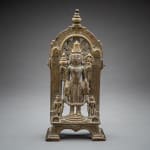Vishnu standing with two attendants on base with mandorla, 1300 CE - 1600 CE
Silver inlaid brass
18.3 x 7.1 cm
7 1/4 x 2 3/4 in
7 1/4 x 2 3/4 in
SF.091
Further images
Vishnu is one of the principal deities of Hinduism and along with Brahma and Shiva, they form a Hindu holy trinity (Trimurti). Vishnu is similar to the formless metaphysical concept...
Vishnu is one of the principal deities of Hinduism and along with Brahma and Shiva, they form a Hindu holy trinity (Trimurti). Vishnu is similar to the formless metaphysical concept called Brahman, the supreme, that takes various avatars in the forms of incarnations thus becoming "the preserver, protector" whenever the world is threatened with evil and chaos by destructive forces. In Hindu inconography, Vishnu is usually depicted as having a dark, or pale blue complexion and having four arms. He holds a padma (lotus flower) in his lower left hand, the Kaumodaki gada (mace) in his lower right hand, the Panchajanya shankha (conch) in his upper left hand and the Sudarshana Chakra (discus) in his upper right hand. The two devotees standing in much smaller size on either side of the god are Sridevi and Bhudevi, representing the two equal spirits of Goddess Lakshmi, the consort of Vishnu. The piece has silver inlaid eyes and is stylistically endemic of the Gujarat region in Western India. - (SF.091)





